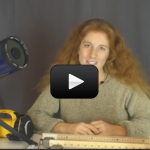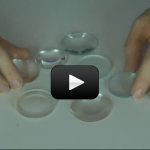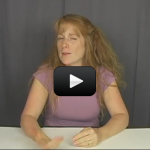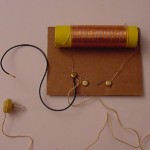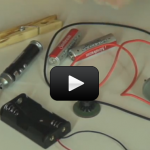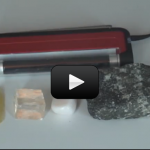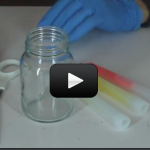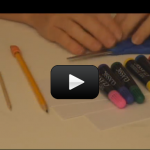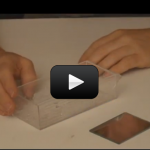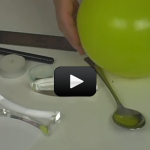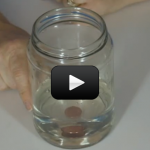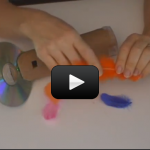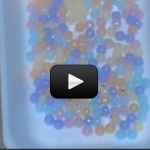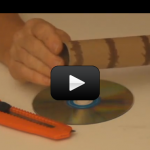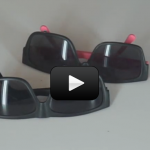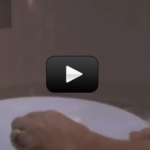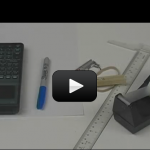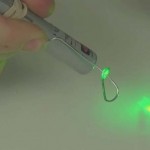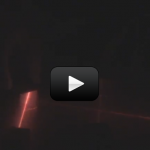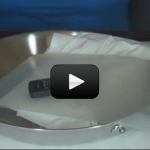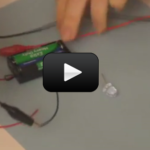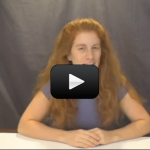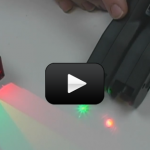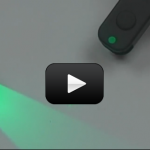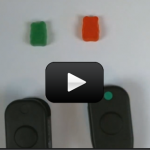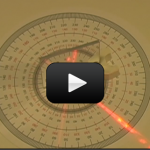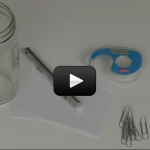Advanced Telescope Building
So you've played with lenses, mirrors, and built an optical bench. Want to make a real telescope? In this experiment, you'll build a Newtonian and a refractor telescope using your optical bench.Materials:optical benchindex card or white walltwo double-convex lensesconcave mirrorpopsicle stickmirrorpaper clipflash lightblack garbage bagscissors or razorrubber bandwax paperhot glue |
Light, Lasers, and Optics
When I was in grad school, I needed to use an optical bench to see invisible things. I was trying to ‘see’ the exhaust from a new kind of F15 engine, because the aircraft acting the way it shouldn’t – when the pilot turned the controls 20o left, the plane only went 10o. My team … Continue reading "Light, Lasers, and Optics" |
Wave-Particle Duality of Light
Light acts like both a particle and a wave, but never both at the same time. But you need both of these concepts in order to fully describe how light works. Energy can take one of two forms: matter and light (called electromagnetic radiation). Light is energy in the form of either a particle (like … Continue reading "Wave-Particle Duality of Light" |
Crystal Radio
In addition to laser experiments, I thought you’d like to learn how to pick up sound that’s traveling on a light wave. A crystal radio is among the simplest of radio receivers – there’s no battery or power source, and nearly no moving parts. The source of power comes directly from the radio waves (which … Continue reading "Crystal Radio" |
Laser Light Show
What happens when you shine a laser beam onto a spinning mirror? In the Laser Maze experiment, the mirrors stayed put. What happens if you took one of those mirrors and moved it really fast? It turns out that a slightly off-set spinning mirror will make the laser dot on the wall spin in a … Continue reading "Laser Light Show" |
Black Light Treasure Hunt
Ever notice how BRIGHT your white t-shirt looks in direct sun? That’s because mom washed with fluorescent laundry soap (no kidding!). The soap manufacturers put in dyes that glow white under a UV light, which make your clothes appear whiter than they really are. Since light is a form of energy, in order for things … Continue reading "Black Light Treasure Hunt" |
Mixing Cold Light
Here’s a trick question – can you make the color “yellow” with only red, green, and blue as your color palette? If you’re a scientist, it’s not a problem. But if you’re an artist, you’re in trouble already. The key is that we would be mixing light, not paint. Mixing the three primary colors of … Continue reading "Mixing Cold Light" |
Mixing Colors
There are three primary colors of light are red, green, and blue. The three primary colors of paint are red, yellow, and blue (I know it's actually cyan, yellow, and magenta, which we'll get to in more detail later, but for now just stick with me and think of the primary colors of paint as red-yellow-blue … Continue reading "Mixing Colors" |
Liquid Prism
In this experiment, water is our prism. A prism un-mixes light back into its original colors of red, green, and blue. You can make prisms out of glass, plastic, water, oil, or anything else you can think of that allows light to zip through. What’s a prism? Think of a beam of light. It zooms … Continue reading "Liquid Prism" |
Eyeballoon
In this lab, we are going to make an eyeball model using a balloon. This experiment should give you a better idea of how your eyes work. The way your brain actually sees things is still a mystery, but using the balloon we can get a good working model of how light gets to your … Continue reading "Eyeballoon" |
Light Tricks
When light rays strikes a surface, part of the beam passes through the surface and the rest reflects back, like a ball bouncing on the ground. Where it bounces depends on how you throw the ball. Have you ever looked into a pool of clear, still water and seen your own face? The surface of … Continue reading "Light Tricks" |
Diffraction
Ever play with a prism? When sunlight strikes the prism, it gets split into a rainbow of colors. Prisms un-mix the light into its different wavelengths (which you see as different colors). Diffraction gratings are tiny prisms stacked together.When light passes through a diffraction grating, it splits (diffracts) the light into several beams traveling at … Continue reading "Diffraction" |
Fun with UV
UV (ultra-violet) light is invisible, which means you need more than your naked eyeball to do experiments with it. Our sun gives off light in the UV. Too much exposure to the sun and you’ll get a sunburn from the UV rays. There are many different experiments you can do with UV detecting materials, such … Continue reading "Fun with UV" |
Spectrometer
Spectrometers are used in chemistry and astronomy to measure light. In astronomy, we can find out about distant stars without ever traveling to them, because we can split the incoming light from the stars into their colors (or energies) and “read” what they are made up of (what gases they are burning) and thus determine … Continue reading "Spectrometer" |
The Dark and Light of Polarization
Polarization has to do with the direction of the light. Think of a white picket fence – the kind that has space between each board. The light can pass through the gaps int the fence but are blocked by the boards. That’s exactly what a polarizer does. When you have two polarizers, you can rotate … Continue reading "The Dark and Light of Polarization" |
Microwaving Soap
When you warm up leftovers, have you ever wondered why the microwave heats the food and not the plate? (Well, some plates, anyway.) It has to do with the way microwaves work. |
Measure your Hair Width with a Laser
Do you have thick or thin hair? Let’s find out using a laser to measure the width of your hair and a little knowledge about diffraction properties of light. (Since were using lasers, make sure you’re not pointing a laser at anyone, any animal, or at a reflective surface.) |
Laser Microscope
Did you know that you can use a laser to see tiny paramecia in pond water? We’re going to build a simple laser microscope that will shine through a single drop of water and project shadows on a wall or ceiling for us to study. |
Laser Maze
By using lenses and mirrors, you can bounce, shift, reflect, shatter, and split a laser beam. Since the laser beam is so narrow and focused, you’ll be able to see several reflections before it fades away from scatter. Make sure you complete the Laser Basics experiment first before working with this experiment. You’ll need to … Continue reading "Laser Maze" |
How to “See” Infra-Red Light
Crazy Remote Want to have some quick science fun with your TV remote? Then try this experiment next time you flip on the tube: Materials: metal frying pan or cookie sheet TV remote control plastic sheet |
Electric Eye
This is a super-cool and ultra-simple circuit experiment that shows you how a CdS (cadmium sulfide cell) works. A CdS cell is a special kind of resistor called a photoresistor, which is sensitive to light. A resistor limits the amount of current (electricity) that flows through it, and since this one is light-sensitive, it will … Continue reading "Electric Eye" |
Measuring the Speed of Light with a Chocolate Bar
When you warm up leftovers, have you ever wondered why the microwave heats the food and not the plate? (Well, some plates, anyway.) It has to do with the way microwave ovens work. Microwave ovens use dielectric heating (or high frequency heating) to heat your food. Basically, the microwave oven shoots light beams that are … Continue reading "Measuring the Speed of Light with a Chocolate Bar" |
Laser Collimation
Laser light is collimated, meaning that it travels in parallel rays. Here’s a really cool experiment that will show you the difference between a non-collimated light, like from a flashlight and collimated light from a laser. Ordinary light from a light bulb diverges as it travels. It spreads out and covers a larger and larger … Continue reading "Laser Collimation" |
Laser Coherence
Lasers light is different from light from a flashlight in a couple of different ways. Laser light is monochromatic, meaning that it’s only one color. Laser light is also coherent, which means that the light is all in synch with each other, like soldiers marching in step together. Since laser light is coherent, which means … Continue reading "Laser Coherence" |
Gummy Bears, Absorption, and Transmittance
Gummy bears are a great way to bust one of the common misconceptions about light reflection. The misconception is this: most students think that color is a property of matter, for example if I place shiny red apple of a sheet of paper in the sun, you’ll see a red glow on the paper around … Continue reading "Gummy Bears, Absorption, and Transmittance" |
Reflection Law using a Laser
The angle that the reflected light makes with a line perpendicular to to the mirror is always equal to the angle of the incident ray for a plane (2-dimensional) surface. We’re going to play with how light reflects off surfaces. At what angle does the light get reflected? This experiment will show you how to … Continue reading "Reflection Law using a Laser" |
Refraction using Lasers and Water
This simple activity has surprising results! We’re going to bend light using plain water. Light bends when it travels from one medium to another, like going from air to a window, or from a window to water. Each time it travels to a new medium, it bends, or refracts. When light refracts, it changes speed … Continue reading "Refraction using Lasers and Water" |

